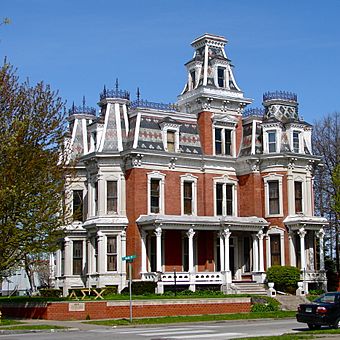J. Monroe Parker–Ficke House facts for kids
|
J. Monroe Parker–Ficke House
|
|
|
U.S. Historic district
Contributing property |
|
 |
|
| Location | 1208 Main St. Davenport, Iowa |
|---|---|
| Area | less than one acre |
| Built | 1881 |
| Architect | T. W. McClelland Victor Huot |
| Architectural style | Second Empire |
| Part of | College Square Historic District (ID83003628) |
| MPS | Davenport MRA |
Quick facts for kids Significant dates |
|
| Added to NRHP | November 18, 1983 |
The J. Monroe Parker–Ficke House is a historic building in Davenport, Iowa. It is located within the College Square Historic District. This district was added to the National Register of Historic Places in 1983. The house itself was also listed on the Davenport Register of Historic Properties in 2003.
Contents
History of the Parker–Ficke House
This house was built in 1881 for James Monroe Parker. He was a very successful businessman in Davenport. The famous local builder T. W. McClelland designed and constructed the house. It's possible that Benjamin W. Gartside, an architect working with McClelland, was the actual designer. Victor Huot, another Davenport architect, was responsible for the unique slate roof. Since 1978, the building has been used as a fraternity house. It is home to the Delta Sigma Chi fraternity from the Palmer College of Chiropractic.
Charles August Ficke's Story
The J. Monroe Parker–Ficke House is strongly connected to Charles August Ficke (1850-1931). He was a well-known lawyer, politician, and property developer in Davenport. Ficke was born in Germany and moved to Davenport as a young child in 1851. He became a lawyer in 1877 after studying law.
Ficke's Political Career
Like many people of German background at that time, Ficke changed his political party. He switched from the Republican Party to the Democratic Party. In 1886, he became the first attorney for Scott County, Iowa. Later, he served as Mayor of Davenport from 1890 to 1891.
During his time as mayor, the city made many improvements. Davenport created a Public Works Department and established LeClaire Park. There were also better street paving and new sewer systems. Ficke was also the first mayor to use his power to reject a decision made by the city council.
Ficke's Impact on Davenport
Charles A. Ficke was involved in several important projects in downtown Davenport. One example is the Ficke Block, which is also a historic building. His large art collection was the starting point for the Davenport Museum of Art. This museum's collection is now housed in the Figge Art Museum. Ficke's son, Arthur Davison Ficke, who became a famous poet, lived in this house during his teenage years.
House Architecture and Design
The J. Monroe Parker–Ficke House is a two-story building made of brick. It has an interesting and unique shape. A key feature is its mansard roof, which has a distinctive shape with four sloping sides. The roof is covered with colorful slate tiles. The house also has decorative wrought-iron details on the roof. You can see fancy brackets, moldings, and unique designs around the windows.
The house is beautifully put together and shows great craftsmanship. It is a wonderful example of the "Victorian excess" style of the time. Many consider it one of the best examples of Second Empire style in all of Iowa.



